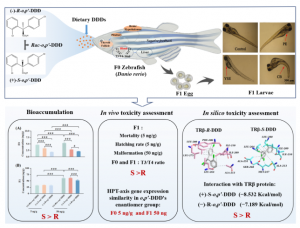Enantioselective maternal transfer of pesticide metabolite and its thyroid effects
FAYETTEVILLE, GA, UNITED STATES, November 26, 2025 /EINPresswire.com/ -- Estimating the multigenerational effects of chiral pesticide metabolites is essential for fully understanding their ecological impacts. This study demonstrated that S-o,p’-DDD accumulated preferentially in adult zebrafish and transferred more efficiently to their offspring compared to the R-enantiomer, leading to pronounced developmental defects and endocrine disruption across both generations. Molecular docking against key thyroid-related proteins provided a mechanistic explanation for this stereospecific toxicity. These findings suggest that evaluating only racemic mixtures may underestimate real-world hazards.
A new study published in Environmental Chemistry and Ecotoxicology has revealed that two mirror-image forms of a persistent pesticide metabolite behave differently when they move from mother fish to their offspring — demonstrating their environmental risks. Chiralmolecules that are mirror images of each other, like left and right hands.
“We were motivated by a simple question,” says lead author Lili Niu. “Many pesticides exist in two mirror-image forms, but environmental assessments usually treat them as if they’re the same. We wanted to know whether that assumption is actually safe, especially across generations.”
To answer this, the researchers fed adult zebrafish diets containing each form of o,p'-DDD for four weeks. They then measured how much of the chemical accumulated in the adults and how much was passed to their developing embryos, as well as tracked hatching success, deformities, survival, and changes in thyroid hormones, which are essential for healthy growth.
“We found that offspring consistently carried even higher chemical levels than their parents, showing that maternal transfer was highly efficient,” shares Niu. “The S-enantiomer accumulated 134-176% more in adults and over 100% more in their larvae than its mirror-image R-form. This led to more severe outcomes in the next generation, including increased mortality, malformations, and reduced hatching success in the S-DDD exposed groups.”
To understand why, the team used computer-based modeling to simulate how each form of the chemical interacts with key proteins involved in producing and regulating thyroid hormones. “These simulations showed that S-DDD binds more strongly to several of these proteins, helping explain its greater biological impact,” says Niu. “What surprised us most was how consistently the S-form caused stronger effects at every level we tested.”
Notably, a small structural difference in the molecule led to very large differences in how much accumulated in the fish, how it affected their hormone system, and how their offspring developed.
The team emphasised that understanding enantiomer-specific effects will help improve ecological risk predictions for long-lasting pollutants and support the development of more accurate environmental standards.
“If we ignore these differences, we risk underestimating long-term harm to wildlife,” adds Niu. “Our work shows that even very low exposure in parents can create meaningful risks for the next generation.”
References
DOI
10.1016/j.enceco.2025.10.021
Original Source URL
https://doi.org/10.1016/j.enceco.2025.10.021
Funding Information
This work was supported by the National Natural Science Foundation of China (No. 42277396 and 22076170) and the Key Research and Development Project of Zhejiang Province (No. 2024C03232).
Lucy Wang
BioDesign Research
email us here
Legal Disclaimer:
EIN Presswire provides this news content "as is" without warranty of any kind. We do not accept any responsibility or liability for the accuracy, content, images, videos, licenses, completeness, legality, or reliability of the information contained in this article. If you have any complaints or copyright issues related to this article, kindly contact the author above.

